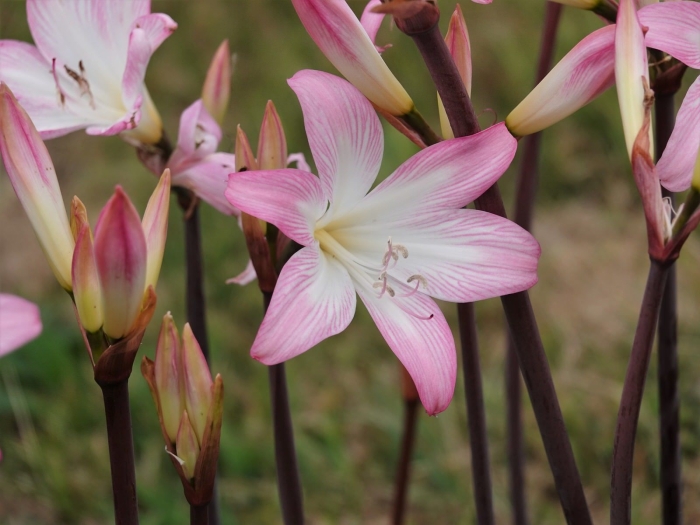Jersey Lily
(Amaryllis belladonna)
Jersey Lily (Amaryllis belladonna)
/
/

Jacqui Geux
CC BY 4.0
Image By:
Jacqui Geux
Recorded By:
Copyright:
CC BY 4.0
Copyright Notice:
Photo by: Jacqui Geux | License Type: CC BY 4.0 | License URL: http://creativecommons.org/licenses/by/4.0/ | Rights Holder: Jacqui Geux | Publisher: iNaturalist | Date Created: 2019-03-15T14:29:45-07:00 |























Estimated Native Range
Summary
Amaryllis belladonna, commonly known as Jersey lily or naked-lady-lily, is a perennial bulbous plant native to the Cape Province of South Africa, specifically to rocky outcrops and sandy plains. It is deciduous, with a growth cycle that begins with the flowering stage in late summer before the leaves develop. The plant typically reaches a height of 18-24 inches (45-60 cm) and produces fragrant, trumpet-shaped pink flowers on leafless stems, creating a striking display against the landscape. After flowering, strap-shaped leaves emerge and persist through winter and spring.
The Jersey lily is valued for its drought tolerance and ability to thrive in well-drained soils, making it suitable for xeriscaping and Mediterranean gardens. It is often used in borders, rock gardens, and as a focal point in plantings due to its distinctive flowering habit. In cultivation, it requires full sun to light shade and prefers a warm, dry rest period in summer to ensure prolific blooming. While generally low-maintenance, it can be susceptible to red blotch (Stagonospora curtisii) and bulb rot if overwatered. Amaryllis belladonna should be planted with caution outside its native range, as it has the potential to become invasive, particularly in similar Mediterranean climates.CC BY-SA 4.0
The Jersey lily is valued for its drought tolerance and ability to thrive in well-drained soils, making it suitable for xeriscaping and Mediterranean gardens. It is often used in borders, rock gardens, and as a focal point in plantings due to its distinctive flowering habit. In cultivation, it requires full sun to light shade and prefers a warm, dry rest period in summer to ensure prolific blooming. While generally low-maintenance, it can be susceptible to red blotch (Stagonospora curtisii) and bulb rot if overwatered. Amaryllis belladonna should be planted with caution outside its native range, as it has the potential to become invasive, particularly in similar Mediterranean climates.CC BY-SA 4.0
Plant Description
- Plant Type: Herb, Bulb
- Height: 2-3 feet
- Width: 2-3 feet
- Growth Rate: Moderate
- Flower Color: Pink
- Flowering Season: Summer, Fall
- Leaf Retention: Deciduous
Growth Requirements
- Sun: Full Sun, Part Shade
- Water: Low, Medium
- Drainage: Fast, Medium
Common Uses
Border Plant, Butterfly Garden, Deer Resistant, Drought Tolerant, Low Maintenance, Potted Plant
Natural Habitat
Native to rocky outcrops and sandy plains in the Cape Province of South Africa
Other Names
Common Names: March Lily, Easter-Lily, Jersey Lily, Beladona-Do-Cabo, Naked Lady, Lírio-Beladona
Scientific Names: , Amaryllis belladonna, Amaryllis belladonna subsp. baptisa-alba, Amaryllis belladonna subsp. baptisa-multiflora, Amaryllis belladonna subsp. baptisa-rosea, Amaryllis belladonna subsp. blanda, Amaryllis belladonna subsp. rosea-perfecta, Amaryllis belladonna var. belladonna, Amaryllis belladonna var. latifolia, Amaryllis belladonna var. maxima
GBIF Accepted Name: